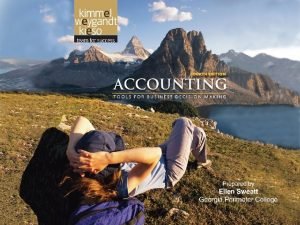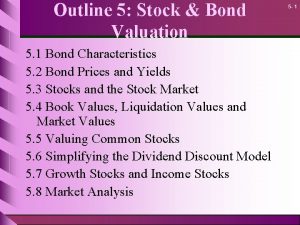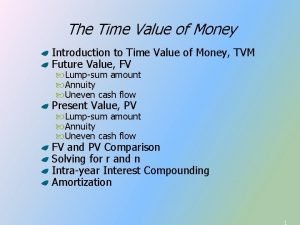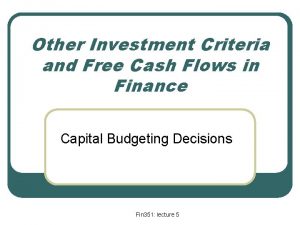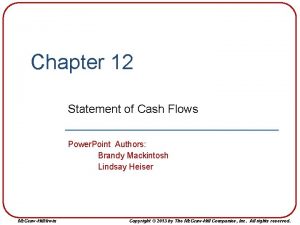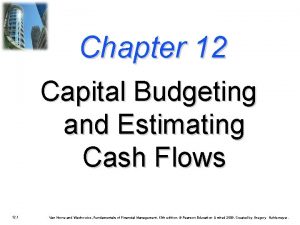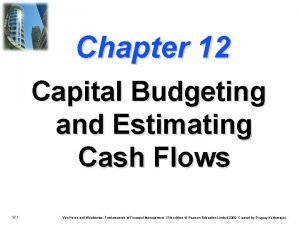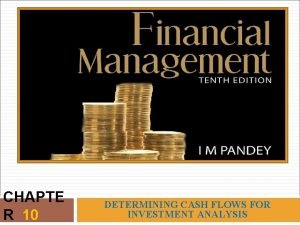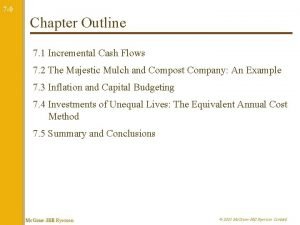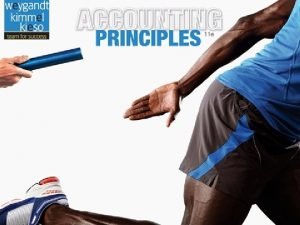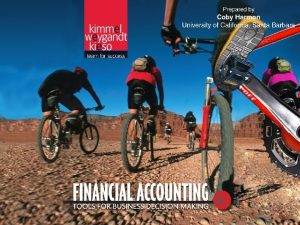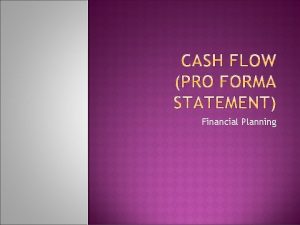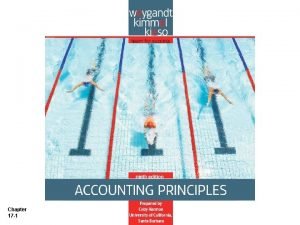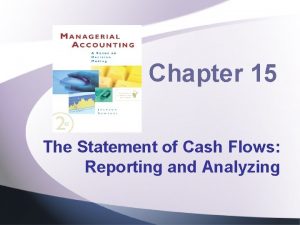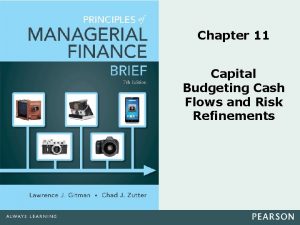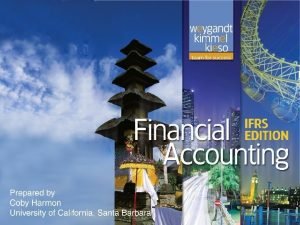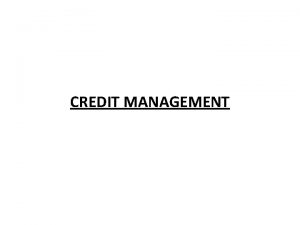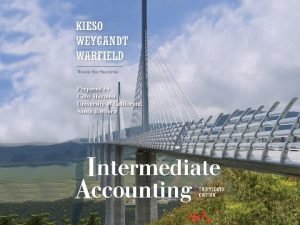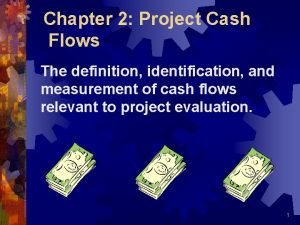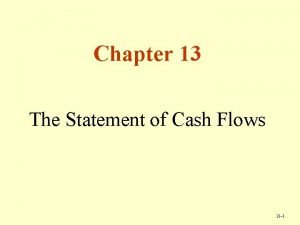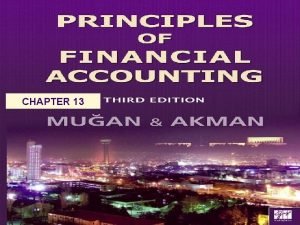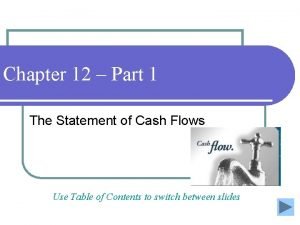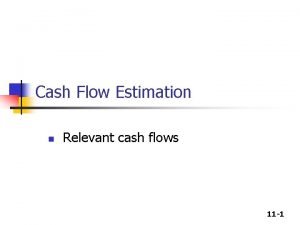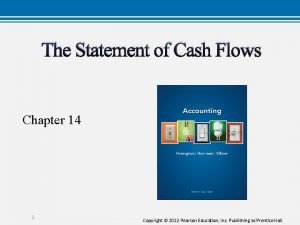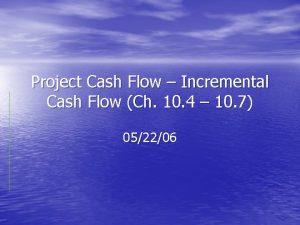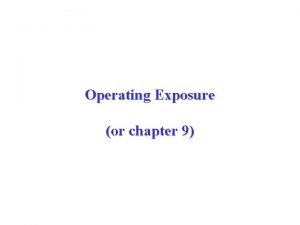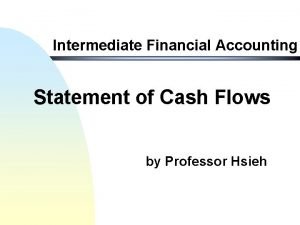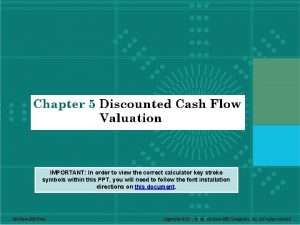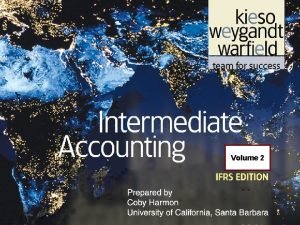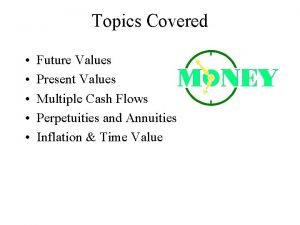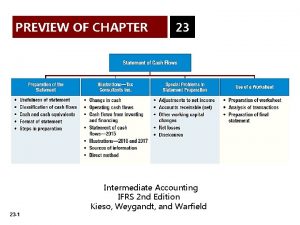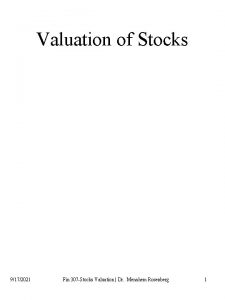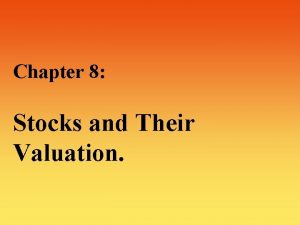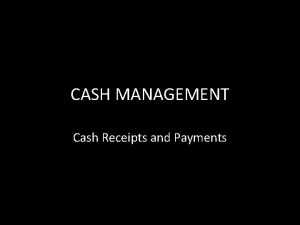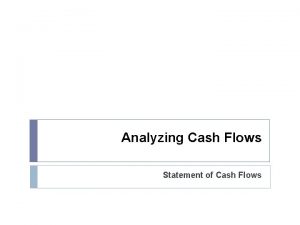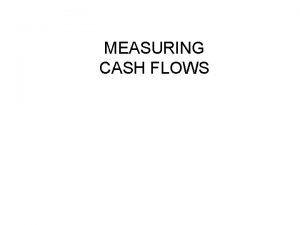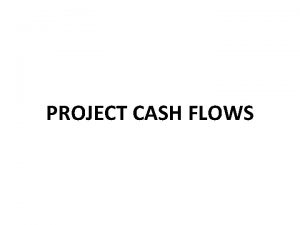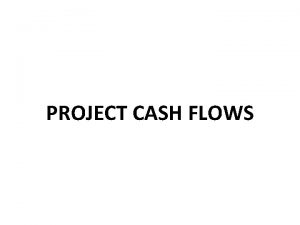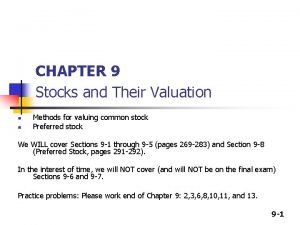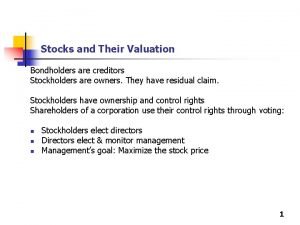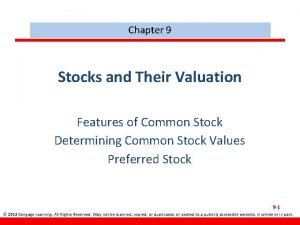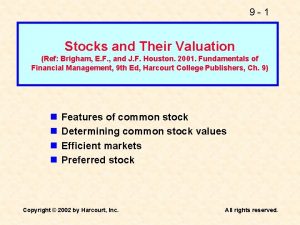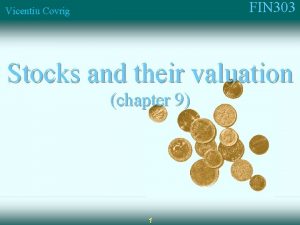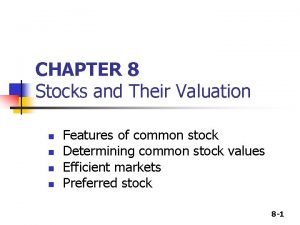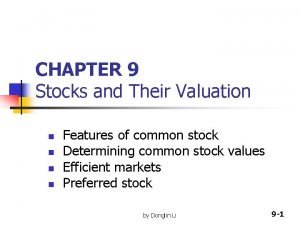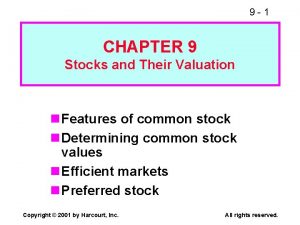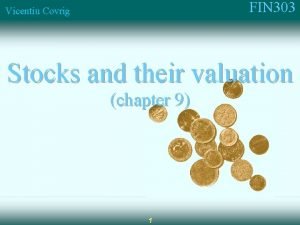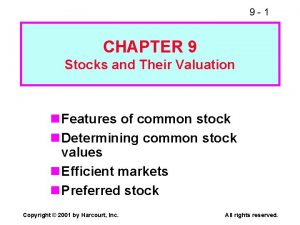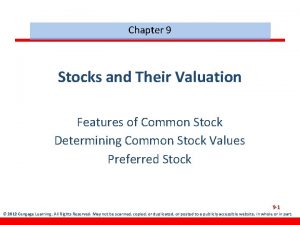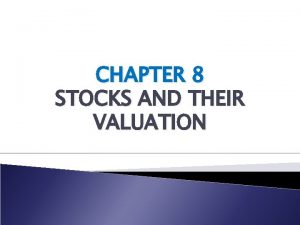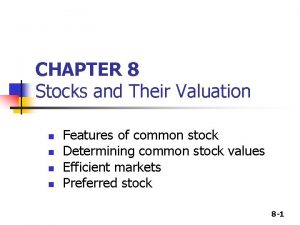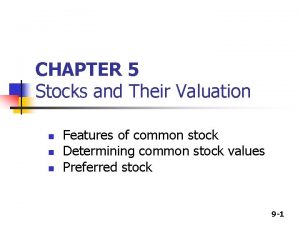Stocks and Their Valuation 8 1 Cash Flows


































- Slides: 34

Stocks and Their Valuation 8 -1

Cash Flows for Stockholders n If you buy a share of stock, you can receive cash in two ways n n n The company pays dividends You sell your shares, either to another investor in the market or back to the company As with bonds, the price of the stock is the present value of these expected cash flows 8 -2

One Period Example n Suppose you are thinking of purchasing the stock of Moore Oil, Inc. and you expect it to pay a $2 dividend in one year and you believe that you can sell the stock for $14 at that time. If you require a return of 20% on investments of this risk, what is the maximum you would be willing to pay? n Compute the PV of the expected cash flows n Price = (14 + 2) / (1. 2) = $13. 33 8 -3

Two Period Example n Now what if you decide to hold the stock for two years? In addition to the dividend in one year, you expect a dividend of $2. 10 in two years and a stock price of $14. 70 at the end of year 2. Now how much would you be willing to pay? n PV = 2 / (1. 2) + (2. 10 + 14. 70) / (1. 2)2 = 13. 33 8 -4

Three Period Example n Finally, what if you decide to hold the stock for three years? In addition to the dividends at the end of years 1 and 2, you expect to receive a dividend of $2. 205 at the end of year 3 and the stock price is expected to be $15. 435. Now how much would you be willing to pay? n PV = 2 / 1. 2 + 2. 10 / (1. 2)2 + (2. 205 + 15. 435) / (1. 2)3 = 13. 33 8 -5

Developing The Model n You would find that the price of the stock is really just the present value of all expected future dividends n So, how can we estimate all future dividend payments? 8 -6

Estimating Dividends: Special Cases n n n Constant dividend n The firm will pay a constant dividend forever n This is like preferred stock n The price is computed using the perpetuity formula Constant dividend growth n The firm will increase the dividend by a constant percent every period Supernormal growth n Dividend growth is not consistent initially, but settles down to constant growth eventually 8 -7

Zero Growth n If dividends are expected at regular intervals forever, then this is a perpetuity and the present value of expected future dividends can be found using the perpetuity formula n n P 0 = D / R Suppose stock is expected to pay a $0. 50 dividend every quarter and the required return is 10% with quarterly compounding. What is the price? n P 0 =. 50 / (. 1 / 4) = $20 8 -8

Preferred stock n n Like bonds, preferred stockholders receive a fixed dividend that must be paid before dividends are paid to common stockholders. However, companies can omit preferred dividend payments without fear of pushing the firm into bankruptcy. 8 -9

If preferred stock with an annual dividend of $5 sells for $50, what is the preferred stock’s expected return? V p = D / kp $50 = $5 / kp kp = $5 / $50 = 0. 10 = 10% 8 -10

Dividend growth model n Value of a stock is the present value of the future dividends expected to be generated by the stock. 8 -11

Constant growth stock n A stock whose dividends are expected to grow forever at a constant rate, g. D 1 = D 0 (1+g)1 D 2 = D 0 (1+g)2 Dt = D 0 (1+g)t n If g is constant, the dividend growth formula converges to: 8 -12

What happens if g > ks? n n If g > ks, the constant growth formula leads to a negative stock price, which does not make sense. The constant growth model can only be used if: n n ks > g g is expected to be constant forever 8 -13

If D 0 = $2 and g is a constant 6%, find the expected dividend stream for the next 3 years, and their PVs. 0 g = 6% D 0 = 2. 00 1 2 2. 12 2. 247 3 2. 382 1. 8761 1. 7599 ks = 13% 1. 6509 8 -14

What is the stock’s market value? n Using the constant growth model: 8 -15

Example n n Suppose Big D, Inc. just paid a dividend of $. 50. It is expected to increase its dividend by 2% per year. If the market requires a return of 15% on assets of this risk, how much should the stock be selling for? P 0 =. 50(1+. 02) / (. 15 -. 02) = $3. 92 8 -16

What is the expected market price of the stock, one year from now? n n D 1 will have been paid out already. So, P 1 is the present value (as of year 1) of D 2, D 3, D 4, etc. Could also find expected P 1 as: 8 -17

What is the expected dividend yield, capital gains yield, and total return during the first year? n Dividend yield = D 1 / P 0 = $2. 12 / $30. 29 = 7. 0% n Capital gains yield = (P 1 – P 0) / P 0 = ($32. 10 - $30. 29) / $30. 29 = 6. 0% n Total return (ks) = Dividend Yield + Capital Gains Yield = 7. 0% + 6. 0% = 13. 0% 8 -18

Finding the Required Return Example n n n Suppose a firm’s stock is selling for $10. 50. They just paid a $1 dividend and dividends are expected to grow at 5% per year. What is the required return? n R = [1(1. 05)/10. 50] +. 05 = 15% What is the dividend yield? n 1(1. 05) / 10. 50 = 10% What is the capital gains yield? n g =5% 8 -19

What would the expected price today be, if g = 0? n 0 The dividend stream would be a perpetuity. ks = 13% 1 2 3 . . . 2. 00 8 -20

Supernormal growth: What if g = 30% for 3 years before achieving long-run growth of 6%? n n Can no longer use just the constant growth model to find stock value. However, the growth does become constant after 3 years. 8 -21

Valuing common stock with nonconstant growth 0 k = 13% 1 s g = 30% D 0 = 2. 00 2 g = 30% 2. 600 3 g = 30% 3. 380 4 . . . g = 6% 4. 394 4. 658 2. 301 2. 647 3. 045 46. 114 54. 107 ^ = P 0 P$ 3 = 4. 658 0. 13 - 0. 06 = $66. 54 8 -22

Find expected dividend and capital gains yields during the first and fourth years. n Dividend yield (first year) = $2. 60 / $54. 11 = 4. 81% n Capital gains yield (first year) = 13. 00% - 4. 81% = 8. 19% n n During nonconstant growth, dividend yield and capital gains yield are not constant, and capital gains yield ≠ g. After t = 3, the stock has constant growth and dividend yield = 7%, while capital gains yield = 6%. 8 -23

Nonconstant growth: What if g = 0% for 3 years before longrun growth of 6%? 0 k = 13% 1 s g = 0% 2 g = 0% D 0 = 2. 00 3 g = 0% 2. 00 4 . . . g = 6% 2. 00 2. 12 1. 77 1. 57 1. 39 20. 99 25. 72 ^ = P 0 P$ 3 = 2. 12 0. 13 - 0. 06 = $30. 29 8 -24

Find expected dividend and capital gains yields during the first and fourth years. n Dividend yield (first year) = $2. 00 / $25. 72 = 7. 78% n Capital gains yield (first year) = 13. 00% - 7. 78% = 5. 22% n After t = 3, the stock has constant growth and dividend yield = 7%, while capital gains yield = 6%. 8 -25

If the stock was expected to have negative growth (g = -6%), would anyone buy the stock, and what is its value? n The firm still has earnings and pays dividends, even though they may be declining, they still have value. 8 -26

Find expected annual dividend and capital gains yields. n Capital gains yield = g = -6. 00% n Dividend yield = 13. 00% - (-6. 00%) = 19. 00% n Since the stock is experiencing constant growth, dividend yield and capital gains yield are constant. Dividend yield is sufficiently large (19%) to offset a negative capital gains. 8 -27

Nonconstant Growth Problem Statement n n Suppose a firm is expected to increase dividends by 20% in one year and by 15% in two years. After that dividends will increase at a rate of 5% per year indefinitely. If the last dividend was $1 and the required return is 20%, what is the price of the stock? Remember that we have to find the PV of all expected future dividends. 8 -28

Nonconstant Growth – Example Solution n Compute the dividends until growth levels off n D 1 = 1(1. 2) = $1. 20 n D 2 = 1. 20(1. 15) = $1. 38 n D 3 = 1. 38(1. 05) = $1. 449 Find the expected future price n P 2 = D 3 / (R – g) = 1. 449 / (. 2 -. 05) = 9. 66 Find the present value of the expected future cash flows 2 n P 0 = 1. 20 / (1. 2) + (1. 38 + 9. 66) / (1. 2) = 8. 67 8 -29

Corporate value model n Also called the free cash flow method. Suggests the value of the entire firm equals the present value of the firm’s free cash flows. 8 -30

Applying the corporate value model n Find the market value (MV) of the firm. n n Subtract MV of firm’s debt and preferred stock to get MV of common stock. n n Find PV of firm’s future FCFs MV of = MV of – MV of debt and common stock firm preferred Divide MV of common stock by the number of shares outstanding to get intrinsic stock price (value). n P 0 = MV of common stock / # of shares 8 -31

Issues regarding the corporate value model n n n Often preferred to the dividend growth model, especially when considering number of firms that don’t pay dividends or when dividends are hard to forecast. Similar to dividend growth model, assumes at some point free cash flow will grow at a constant rate. Terminal value (TVn) represents value of firm at the point that growth becomes constant. 8 -32

Given the long-run g. FCF = 6%, and WACC of 10%, use the corporate value model to find the firm’s intrinsic value. 0 k = 10% 1 -5 -4. 545 8. 264 15. 026 398. 197 416. 942 2 10 3 4 20 g = 6% . . . 21. 20 530 = 0. 10 - 0. 06 = TV 3 8 -33

If the firm has $40 million in debt and has 10 million shares of stock, what is the firm’s intrinsic value per share? n n MV of equity = MV of firm – MV of debt = $416. 94 m - $40 m = $376. 94 million Value per share = MV of equity / # of shares = $376. 94 m / 10 m = $37. 69 8 -34
 The essentials of effective budgeting do not include
The essentials of effective budgeting do not include Valuation of stocks and bonds
Valuation of stocks and bonds Fixed income valuation
Fixed income valuation Pv of cash flows formula
Pv of cash flows formula Incremental cash flows
Incremental cash flows Payback time formula
Payback time formula Cash flow indirect method
Cash flow indirect method Incremental cash flow
Incremental cash flow Incremental cash flow
Incremental cash flow Incremental cash flows definition
Incremental cash flows definition Examples of incremental cash flows
Examples of incremental cash flows Statement of cash flows order
Statement of cash flows order Common stock cash flow
Common stock cash flow Project implementation cost
Project implementation cost Prepaid expenses cash flow statement
Prepaid expenses cash flow statement The statement of cash flows reports
The statement of cash flows reports Capital budgeting
Capital budgeting Juarez company acquired $1 200
Juarez company acquired $1 200 What are the cash flows from granting credit
What are the cash flows from granting credit Chapter 23 statement of cash flows
Chapter 23 statement of cash flows Relevant cash flows definition
Relevant cash flows definition The statement of cash flows classifies items as
The statement of cash flows classifies items as Chapter 13 statement of cash flows
Chapter 13 statement of cash flows Chapter 13 statement of cash flows
Chapter 13 statement of cash flows Statement of cash flows partial
Statement of cash flows partial Relevant cash flow
Relevant cash flow Destiny corporation is preparing its
Destiny corporation is preparing its What is incremental cash flow
What is incremental cash flow What is operating exposure
What is operating exposure Intermediate cash flows
Intermediate cash flows Effective annual rate
Effective annual rate Chapter 23 statement of cash flows
Chapter 23 statement of cash flows Future value of multiple cash flows example
Future value of multiple cash flows example The statement of cash flows helps users
The statement of cash flows helps users Intermediate accounting chapter 23
Intermediate accounting chapter 23
